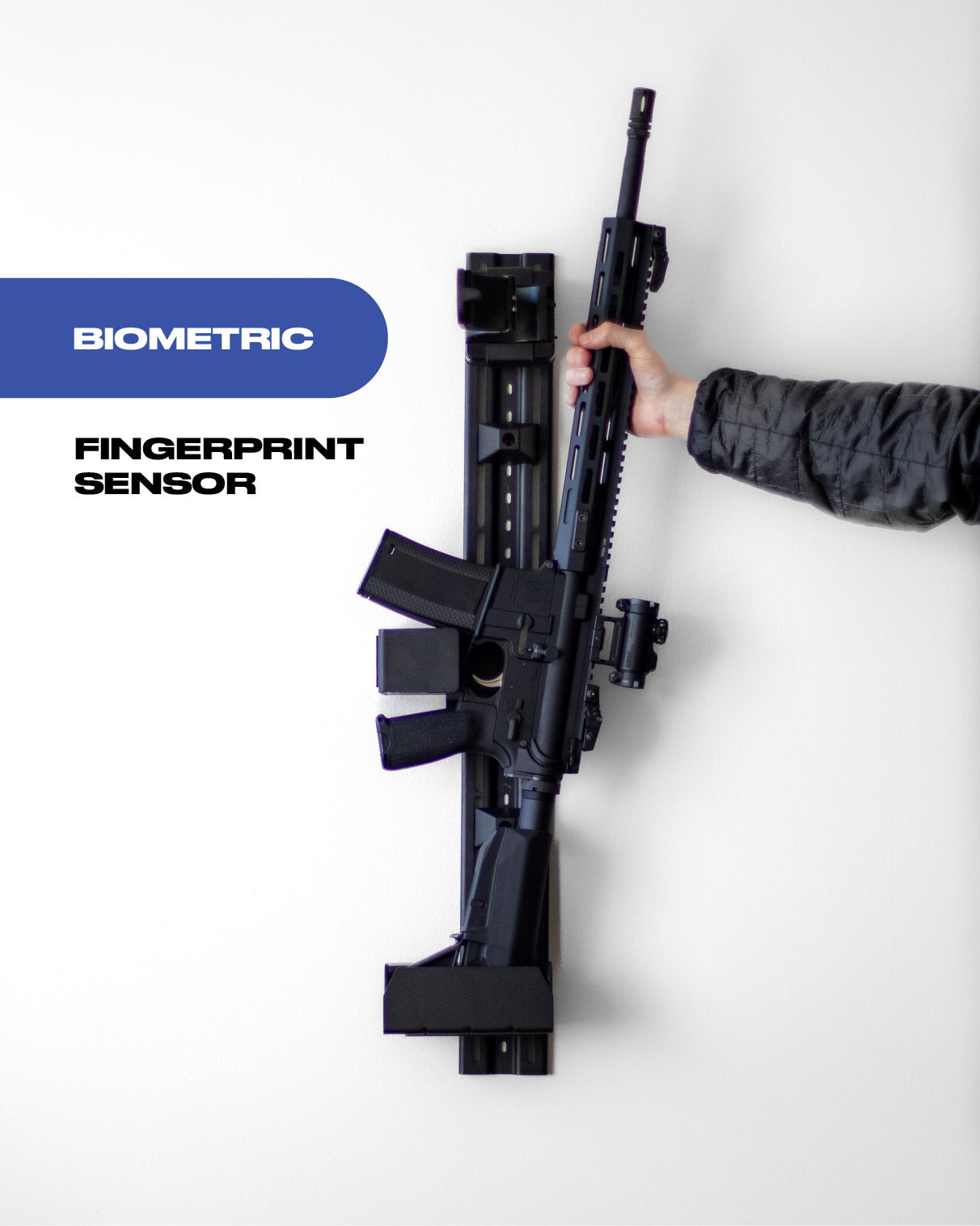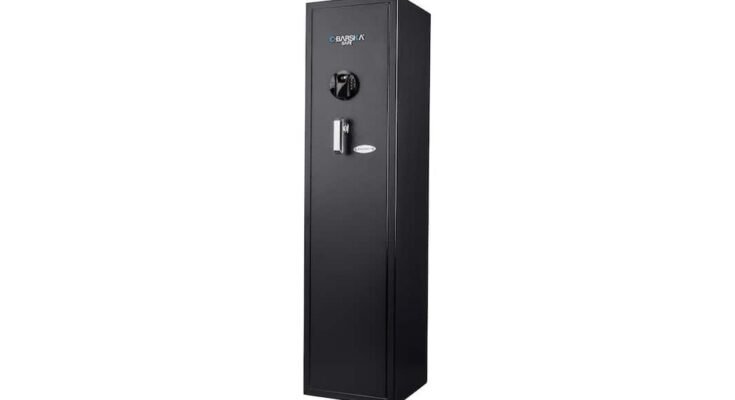Are you worried about keeping your rifles safe and accessible only to you? You’ve probably heard about biometric rifle safes and wondered if they really offer the security you need.
Imagine a safe that opens with just a touch of your finger—fast, convenient, and secure. But can you trust this technology to protect your firearms from unauthorized access? You’ll discover how biometric rifle safes work, their strengths, and what you should watch out for before making a choice.
Keep reading to find out if a biometric safe is the right solution for your security needs.

Biometric Safes Basics
Biometric rifle safes offer a modern way to secure firearms. They use unique physical features to control access. This technology adds a layer of protection beyond traditional locks. Understanding how biometric safes work helps you decide if they fit your security needs.
Biometric safes combine convenience with safety. They respond quickly to authorized users. No need to remember codes or carry keys. This makes them popular for gun owners who want fast and secure access.
How Biometric Technology Works
Biometric technology reads unique parts of your body. Common features include fingerprints, retina patterns, or facial structure. The safe scans these features and compares them to stored data. Only matching scans can open the safe. This stops unauthorized people from gaining entry.
The scanning process is usually fast, often under a second. The safe stores data securely and uses encryption. This protects your biometric information from hacking or theft.
Types Of Biometric Sensors
Fingerprint sensors are the most common in rifle safes. They scan the ridges and patterns on your finger. These sensors work well in various lighting and conditions.
Facial recognition sensors use cameras to identify your face. They map key points on your face for a match. These are less common but offer hands-free access.
Retina scanners look at the unique patterns in your eye. They are very accurate but more expensive. This type is rare in home safes due to cost and size.
Security Features Of Rifle Safes
Rifle safes use many security features to keep firearms safe. These features protect guns from theft and unauthorized use. Understanding these features helps choose the right safe for your needs.
Locking Mechanisms
Biometric rifle safes often use fingerprint scanners for quick access. These scanners read unique fingerprints, allowing only authorized users inside. Some safes also include backup keys or PIN codes for emergencies. The locking system must be reliable and fast to provide both security and convenience.
Material Strength And Construction
The body of a rifle safe is usually made from thick steel. Strong steel resists drilling, cutting, and prying attempts. Solid construction prevents easy break-ins. Welded seams and reinforced corners add extra strength to the safe.
Tamper Resistance
Many safes have alarms that sound if tampering is detected. Some use relockers that lock the safe tighter if forced entry happens. The biometric scanner may lock out after several failed attempts. These features make it harder for thieves to break in.
Advantages Of Biometric Rifle Safes
Biometric rifle safes offer clear benefits for gun owners. They combine security with ease of use. These safes use fingerprint technology to provide fast and reliable access. This modern approach enhances safety and convenience. Understanding these advantages helps decide if a biometric safe fits your needs.
Quick Access In Emergencies
Biometric safes open much faster than traditional locks. A simple fingerprint scan grants immediate entry. No need to search for keys or remember codes. This speed is crucial during urgent situations. It helps ensure timely and safe firearm access.
User Convenience
Fingerprint recognition eliminates the hassle of keys and combinations. Users avoid fumbling with locks in low light. The system is easy to use for people of all ages. It reduces stress and saves time daily. This convenience encourages consistent safe use.
Multiple User Profiles
Biometric safes can store several fingerprints. This allows trusted family members to access the safe. Each profile is unique and secure. It ensures controlled sharing without compromising safety. Managing users is simple and flexible.
Potential Weaknesses
Biometric rifle safes offer convenience and quick access. Still, no security system is perfect. Understanding potential weaknesses helps you make a smart choice. These safes have some common issues that users should know.
Sensor Failures And False Rejections
Biometric sensors can fail to read fingerprints correctly. Dirty or wet fingers may cause errors. Some sensors reject authorized users by mistake. This can delay access in urgent moments. Regular cleaning and maintenance reduce these problems.
Vulnerability To Hacking Or Bypass
Like all electronics, biometric safes can face hacking risks. Skilled hackers might exploit software flaws. Some models allow bypass through physical tools. Choosing safes with strong encryption adds protection. Keep firmware updated to block new threats.
Power And Battery Issues
Biometric safes need power to work. Dead batteries can lock you out. Some safes have backup keys or external power options. Check battery levels often to avoid surprises. Using good quality batteries extends safe operation.
Testing Biometric Safes For Security
Testing biometric rifle safes for security is essential to know how well they protect your firearms. These safes use fingerprint scanners or other biometric data to allow access. It is important to check if these locks truly keep your guns safe from unauthorized use.
Security tests help reveal any weaknesses in the safe’s design or technology. They show how the safe behaves under different conditions and attempts to break in. Understanding these tests helps buyers make smart choices.
Common Testing Methods
Experts test biometric safes using several methods. They try to bypass the fingerprint scanner with fake prints or other tricks. Mechanical locks and electronic parts are examined for vulnerabilities. Sometimes, safes undergo forced entry tests using tools like pry bars or drills. These tests check the strength of the safe’s walls and lock mechanisms.
Real-world Break-in Scenarios
Testing also includes simulating real break-in attempts. This means trying to open the safe without the right fingerprint or code. Techniques used by thieves, such as lock picking or smashing, are applied. These tests show if the safe can stop common criminal methods. They also reveal how fast someone could gain access illegally.
Performance Under Stress
Biometric safes are tested under stress to check reliability. This includes exposing the scanner to dirt, moisture, or low light. The safe must still recognize authorized users quickly. Battery life and power failure responses are also important. Stress tests ensure the safe works well in daily use and emergencies.

Comparing Biometric Safes To Traditional Safes
Comparing biometric rifle safes to traditional safes reveals key differences in security and convenience. Both types protect your firearms but use different locking methods. Understanding these differences helps you choose the best option for your needs. This section breaks down the main factors: lock types, access speed, and long-term reliability.
Mechanical Vs Electronic Locks
Traditional safes often use mechanical locks. These include combination dials or key locks. They do not need power to work. Biometric safes use electronic locks with fingerprint scanners. They require batteries or electricity. Mechanical locks are simple but slower to open. Electronic locks offer quick access but depend on power.
Speed Of Access
Biometric safes provide faster access. A quick fingerprint scan unlocks the safe in seconds. Mechanical safes take longer because you must turn a dial or use a key. Faster access can be crucial in emergencies. This speed makes biometric safes a preferred choice for many gun owners.
Reliability Over Time
Mechanical locks are known for durability. They can last decades without issues. Electronic locks may face problems with batteries or sensors over time. Regular maintenance keeps biometric safes working well. Both types require care, but mechanical safes often need less attention.
Choosing The Right Rifle Safe
Choosing the right rifle safe is an important step for gun owners. It protects your firearms from theft and damage. A good safe also keeps your family safe from accidents. You need to find one that fits your specific needs and budget. Understanding what to look for makes the choice easier.
Assessing Security Needs
Start by thinking about what you want to protect. Are you storing many rifles or just a few? Consider the level of security you need. Some safes have biometric locks that open with fingerprints. These offer quick access but check their reliability. Also, think about fire resistance and how strong the safe is against break-ins. Choose a safe that matches your security needs well.
Budget Considerations
Rifle safes come in many price ranges. Set a budget before shopping. A higher price often means better security features. But some affordable safes still offer good protection. Balance cost with the features you need. Don’t spend too little and risk safety. Spend wisely to get the best value for your money.
Brand Reputation And Reviews
Pick brands known for quality and security. Check customer reviews online to see real experiences. Look for consistent praise on durability and lock systems. Avoid brands with many complaints or poor service. Good reputation often means better product reliability. This helps you avoid problems later on.

Maintenance Tips For Biometric Safes
Biometric rifle safes need care to work well and stay secure. Regular maintenance keeps sensors accurate and safe. Simple steps help avoid problems and extend safe life. Follow these tips to keep your biometric safe reliable every day.
Cleaning Sensors
Clean sensors gently with a soft cloth. Avoid harsh chemicals that can damage sensors. Dirt and oil on fingers can block the scanner. Wipe sensors often to keep them clear and working. Use a dry cloth or one lightly dampened with water.
Battery Replacement
Check battery levels regularly to prevent lockouts. Replace batteries as soon as power runs low. Use the correct battery type recommended by the manufacturer. Low batteries can cause slow or failed scans. Keep spare batteries nearby for quick changes.
Regular Function Testing
Test your safe’s lock and unlock functions often. Try all registered fingerprints for smooth access. Check for delays or errors in recognition. Testing helps find problems early before they get worse. Fix issues quickly to keep your safe secure.
Frequently Asked Questions
Are Biometric Rifle Safes More Secure Than Traditional Safes?
Biometric rifle safes offer faster access and unique fingerprint recognition. They reduce risk of unauthorized entry compared to traditional key or combination locks. However, quality and technology matter for true security.
Can Biometric Safes Be Hacked Or Bypassed?
While biometric safes use advanced fingerprint tech, some low-quality models can be bypassed. Choose safes with encrypted data and anti-tamper features for better protection.
How Reliable Is Fingerprint Recognition In Rifle Safes?
Fingerprint sensors are generally reliable but can struggle with wet or dirty fingers. High-end models improve accuracy and speed, ensuring quick, secure access.
Do Biometric Safes Work During Power Failures?
Most biometric rifle safes have backup power options like batteries. They maintain fingerprint access even during power outages, ensuring uninterrupted security.
Conclusion
Biometric rifle safes offer strong security through fingerprint recognition. They keep firearms safe from unauthorized access quickly. These safes are easy to use and add convenience. Still, no safe is completely foolproof. Regular maintenance and careful use improve safety. Choose a safe that fits your needs and budget.
Trust technology, but stay cautious and informed. Your safety depends on smart decisions and reliable tools.
